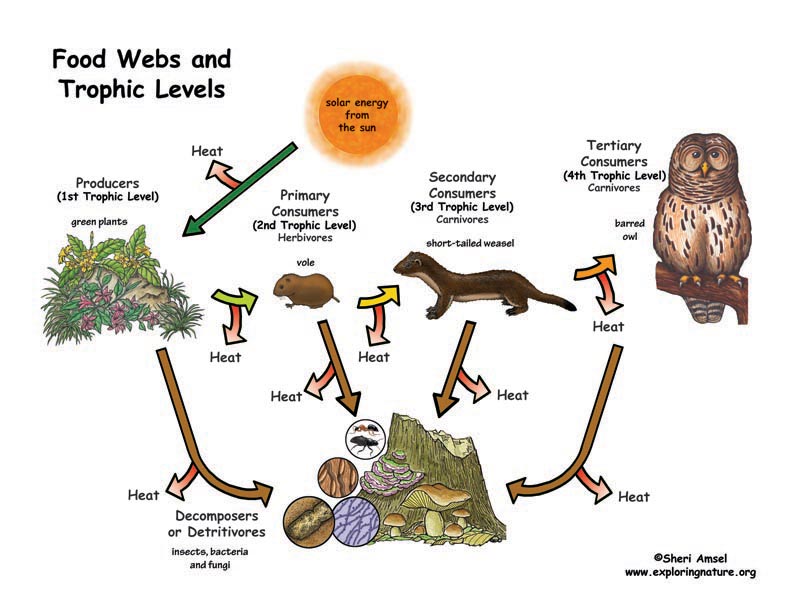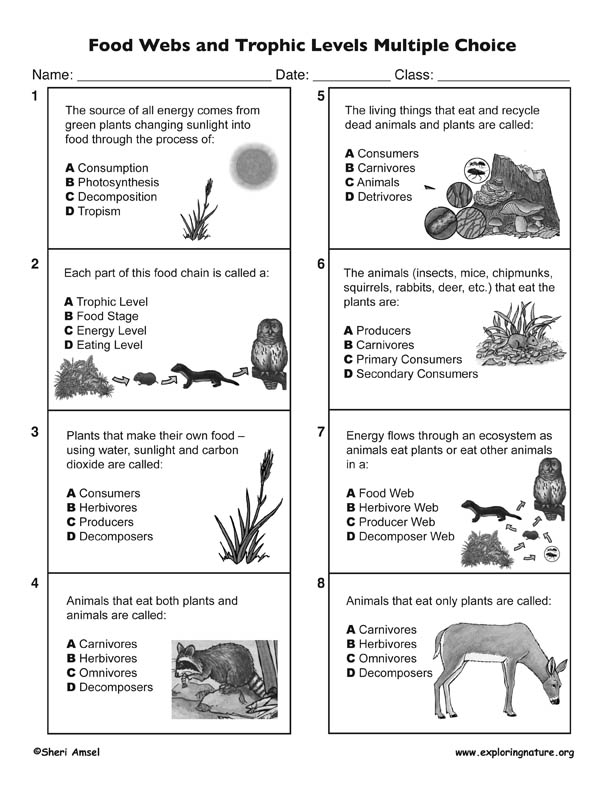

Energy flows through an ecosystem as animals eat plants or other animals in a complex food web. The source of all energy comes from the green plants changing sunlight into food through the process of photosynthesis. There are more plants than any other living thing because they are the bottom of the food chain. They provide the energy for everything else. They are the PRODUCERS.
Some energy is lost each time an animal eats.
This means that one lynx has to eat a lot of snowshoe hairs to maintain its energy, reproduce and grow. And every snowshoe hare must eat a lot of grass and plants to maintain its energy, reproduce and grow. Because there is energy lost at each level of the food chain, it takes a lot of plants to keep one big predator fed up the chain. Because there are fewer animals as you move up the food chain, it is really a food pyramid with the big carnivores needing to eat the most and so being the rarest of the animal kingdom. Because animals eat so many things, the food chain has many overlapping parts, so is really a FOOD WEB.
Each part of this food chain is a trophic level and has a name.
• Plants – which make their own food – using water, sunlight and carbon dioxide (photosynthesis) – are called producers.
• The animals (insects, mice, chipmunks, squirrels, rabbits, deer, etc.) that eat the plants are primary consumers.
• If they eat only plants, they are called herbivores. The animals (spiders, birds, snakes, weasels, etc.) that eat the primary consumers are the secondary consumers.
• If they eat both plants and meat, they are called omnivores. If they eat only meat, they are called carnivores. The animals (fox, coyotes, eagles, owls, hawks, etc.) that eat the secondary consumers are tertiary consumers.
• The living things that eat and recycle dead animals and plants are called the decomposers or detritivores. These include insects, bacteria, mushrooms, and other fungi. At each trophic level, energy is lost as heat.
Essential Questions:
1. Why are there more producers in a food web than consumers?
2. In what ways is energy lost as you move up through a food web?
3. What is the source of all the energy that feeds food webs?
Short answer and multiple choice quizzes, plus a high resolution poster included in the PDF below.
When you research information you must cite the reference. Citing for websites is different from citing from books, magazines and periodicals. The style of citing shown here is from the MLA Style Citations (Modern Language Association).
When citing a WEBSITE the general format is as follows.
Author Last Name, First Name(s). "Title: Subtitle of Part of Web Page, if appropriate." Title: Subtitle: Section of Page if appropriate. Sponsoring/Publishing Agency, If Given. Additional significant descriptive information. Date of Electronic Publication or other Date, such as Last Updated. Day Month Year of access < URL >.
Amsel, Sheri. "About Food Webs and Trophic Levels" Exploring Nature Educational Resource ©2005-2024. December 13, 2024
< http://www.exploringnature.org/db/view/About-Food-Webs-and-Trophic-Levels >

